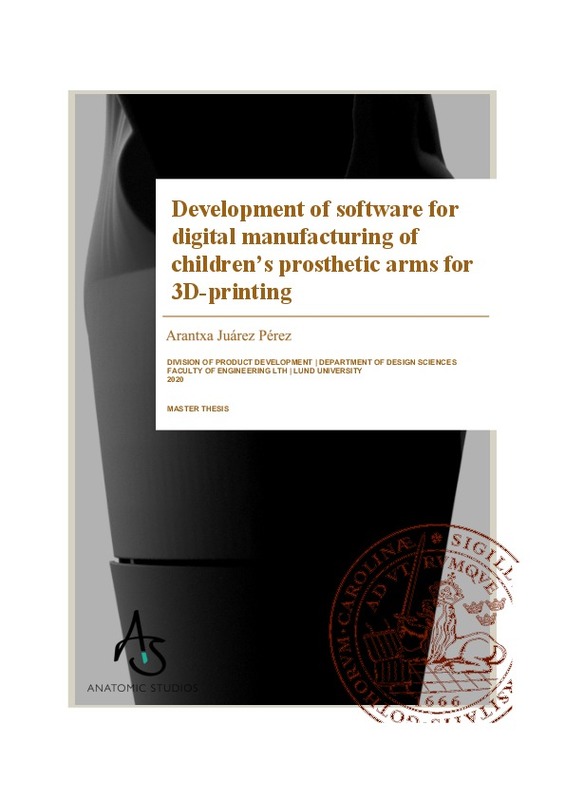JavaScript is disabled for your browser. Some features of this site may not work without it.
Buscar en RiuNet
Listar
Mi cuenta
Estadísticas
Ayuda RiuNet
Admin. UPV
Desarrollo de software para la manufacturación digital de brazos protésicos infantiles para impresión 3D
Mostrar el registro sencillo del ítem
Ficheros en el ítem
| dc.contributor.advisor | Saiz Adalid, Luis José
|
es_ES |
| dc.contributor.advisor | Pérez Jiménez, Alberto José
|
es_ES |
| dc.contributor.author | Juárez Pérez, Arantxa
|
es_ES |
| dc.coverage.spatial | east=13.202714903465504; north=55.71146611101682; name=BMC, Lund, Suècia | es_ES |
| dc.date.accessioned | 2021-02-11T15:45:05Z | |
| dc.date.available | 2021-02-11T15:45:05Z | |
| dc.date.created | 2020-09-08 | |
| dc.date.issued | 2021-02-11 | es_ES |
| dc.identifier.uri | http://hdl.handle.net/10251/161116 | |
| dc.description.abstract | [ES] Desarrollo de un sistema (metodología y software) para el diseño digital de brazos protésicos a partir de un modelo base. El modelo se adecuará a las necesidades de cada individuo. La idea es desarrollar un sistema que autogenere el modelo protésico en cada caso particular. El sistema considerará la inclusión de hasta cuatro articulaciones, las posibles en este tipo de prótesis, así como su adaptación ergonómica al sujeto y la inclusión de los elementos mecánicos y electrónicos necesarios. Dada la complejidad del proceso el objetivo del TGM es desarrollar las bases necesarias para futuros desarrollos. | es_ES |
| dc.description.abstract | [EN] To design a concept (software / methodology) to digitally design a model of arm prosthetic with predesigned shape as a base. The model should be able to be customised to fit every individual's needs. The objective is to develop a way to autogenerate the digital design of the prosthetic. A joint for the robotics hand will be taken into consideration when developing the design. There is a choice of four different joints and the autogenerated design will be able to implement each of them into the model. The model must be compatible with a pattern to the model's exterior. The model should also be designed to fit all the interior components such as batteries, sensors and switches. Circuit switch holes and inspection hatch should be in the design. At the end of the project, the goal is to have at least one arm prosthesis 3D-printed. | es_ES |
| dc.format.extent | 147 | es_ES |
| dc.language | Inglés | es_ES |
| dc.publisher | Universitat Politècnica de València | es_ES |
| dc.rights | Reserva de todos los derechos | es_ES |
| dc.subject | Impresión 3D | es_ES |
| dc.subject | Prótesis | es_ES |
| dc.subject | Grasshopper | es_ES |
| dc.subject | Desarrollo de proceso | es_ES |
| dc.subject | Amputación | es_ES |
| dc.subject | 3D-printing | es_ES |
| dc.subject | Prosthetics | es_ES |
| dc.subject | Process development | es_ES |
| dc.subject | Amputation | es_ES |
| dc.subject.classification | ARQUITECTURA Y TECNOLOGIA DE COMPUTADORES | es_ES |
| dc.subject.other | Máster Universitario en Ingeniería Industrial-Màster Universitari en Enginyeria Industrial | es_ES |
| dc.title | Desarrollo de software para la manufacturación digital de brazos protésicos infantiles para impresión 3D | es_ES |
| dc.type | Tesis de máster | es_ES |
| dc.rights.accessRights | Abierto | es_ES |
| dc.contributor.affiliation | Universitat Politècnica de València. Departamento de Informática de Sistemas y Computadores - Departament d'Informàtica de Sistemes i Computadors | es_ES |
| dc.contributor.affiliation | Universitat Politècnica de València. Escuela Técnica Superior de Ingenieros Industriales - Escola Tècnica Superior d'Enginyers Industrials | es_ES |
| dc.description.bibliographicCitation | Juárez Pérez, A. (2020). Desarrollo de software para la manufacturación digital de brazos protésicos infantiles para impresión 3D. Universitat Politècnica de València. http://hdl.handle.net/10251/161116 | es_ES |
| dc.description.accrualMethod | TFGM | es_ES |
| dc.relation.pasarela | TFGM\126707 | es_ES |
Este ítem aparece en la(s) siguiente(s) colección(ones)
-
ETSII - Trabajos académicos [10404]
Escuela Técnica Superior de Ingenieros Industriales






